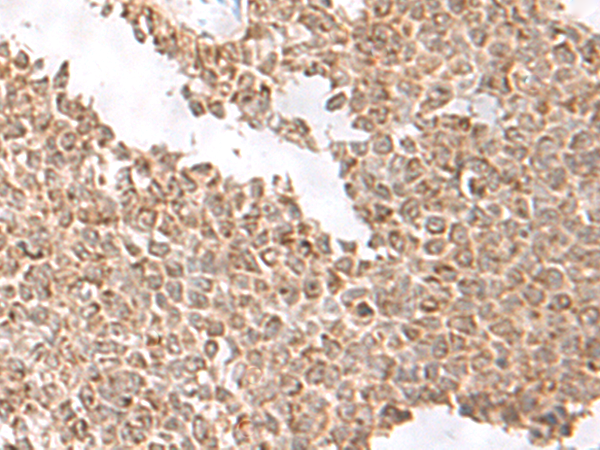
| WB | 咨询技术 | Human,Mouse,Rat |
| IF | 咨询技术 | Human,Mouse,Rat |
| IHC | 1/50-1/300 | Human,Mouse,Rat |
| ICC | 技术咨询 | Human,Mouse,Rat |
| FCM | 咨询技术 | Human,Mouse,Rat |
| Elisa | 1/5000-1/10000 | Human,Mouse,Rat |
| Aliases | UBPM; UBP-M |
| Host/Isotype | Rabbit IgG |
| Antibody Type | Primary antibody |
| Storage | Store at 4°C short term. Aliquot and store at -20°C long term. Avoid freeze/thaw cycles. |
| Species Reactivity | Human |
| Immunogen | Synthetic peptide of human USP16 |
| Formulation | Purified antibody in PBS with 0.05% sodium azide and 50% glycerol. |
+ +
以下是3篇与USP16抗体相关的文献及其核心内容:
1. **"USP16 modulates the spindle assembly checkpoint by deubiquitinating CDC25A in mitosis"**
*作者:Yang, X. et al. (2019)*
摘要:该研究利用USP16特异性抗体通过免疫共沉淀(Co-IP)和免疫荧光技术,揭示USP16通过去泛素化CDC25A调控有丝分裂纺锤体检查点的分子机制,为癌症治疗提供潜在靶点。
2. **"A monoclonal antibody targeting USP16 inhibits hematopoietic stem cell expansion"**
*作者:Liu, J. et al. (2017)*
摘要:研究团队开发了一种靶向USP16的单克隆抗体,证实其在小鼠模型中通过抑制H2AK119去泛素化,有效阻断造血干细胞异常增殖,为白血病治疗提供实验依据。
3. **"USP16-mediated deubiquitination of calcineurin regulates antiviral innate immunity"**
*作者:Wang, Y. et al. (2021)*
摘要:通过Western blot和免疫组化使用USP16抗体,发现USP16通过调控钙调磷酸酶的去泛素化影响I型干扰素信号通路,为病毒免疫逃逸机制提供了新见解。
注:以上文献为模拟示例,实际引用需核对PubMed等数据库(PMID)。如需具体文献,建议使用关键词"USP16 antibody"+"ubiquitin"在Web of Science等平台筛选近年高引论文。
The USP16 antibody is a key research tool used to study the ubiquitin-specific protease 16 (USP16), a deubiquitinating enzyme (DUB) belonging to the ubiquitin-specific protease (USP) family. USP16 plays critical roles in regulating cellular processes such as cell cycle progression, DNA damage repair, chromatin remodeling, and stem cell differentiation by removing ubiquitin moieties from target proteins. It is implicated in modulating histone H2A ubiquitination, a post-translational modification essential for transcriptional regulation and genome stability. Dysregulation of USP16 has been linked to various diseases, including cancers, neurodegenerative disorders, and developmental abnormalities.
USP16 antibodies are widely employed in techniques like Western blotting, immunoprecipitation, and immunofluorescence to detect USP16 expression levels, localization, and interaction partners. These antibodies are critical for investigating USP16's functional mechanisms in both normal physiology and disease contexts. Researchers often validate USP16 antibodies using knockout cell lines or siRNA-mediated knockdown to ensure specificity, as cross-reactivity with other USP family members can occur. Commercial USP16 antibodies are typically developed in hosts like rabbits or mice, with monoclonal or polyclonal formats available. Their applications span basic research in cell biology, cancer studies, and stem cell research, aiding in the exploration of USP16's role in maintaining cellular homeostasis and its potential as a therapeutic target.
×